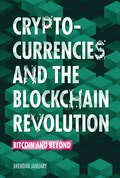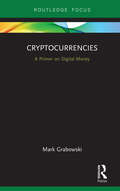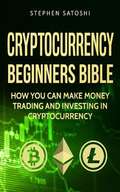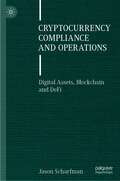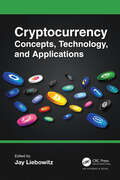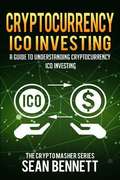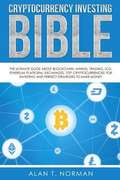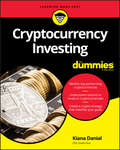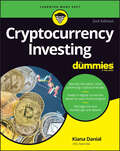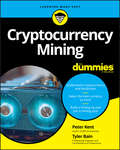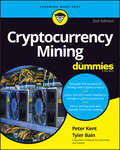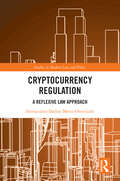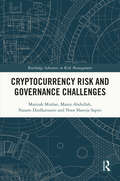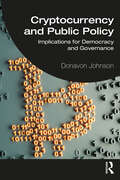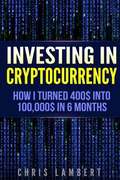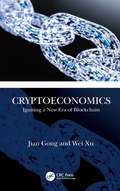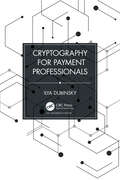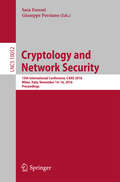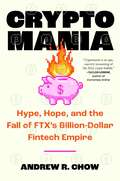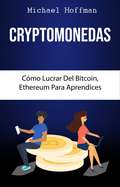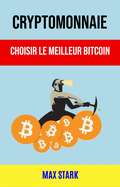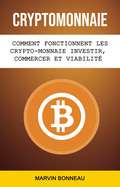- Table View
- List View
Cryptocurrencies and the Blockchain Revolution: Bitcoin and Beyond
by Brendan JanuaryIn January 2009, a mysterious software developer, Satoshi Nakamoto, exchanged a specially designed code with another developer. The code was a digital currency that Nakamoto had proposed several months before in a paper titled “Bitcoin: A Peer-to-Peer Electronic Cash System.” This was the first Bitcoin transaction. Since then, Bitcoin has become the face of a tech revolution in digital cryptocurrencies based on blockchain technology. Its success has sparked a tech revolution that could fundamentally change global economics. Author Brendan January delves into the world of coders, libertarians, criminals, financial regulators, and crypto-detectives to understand what digital cryptocurrencies have to offer, their limitations and potential pitfalls, security issues, and how they may affect government and financial regulations in the future.
Cryptocurrencies: A Primer on Digital Money (Routledge Focus on Economics and Finance)
by Mark GrabowskiAlready in just a decade of existence, cryptocurrencies have been the world’s best-performing financial asset, outperforming stocks, bonds, commodities and currencies. This comprehensive yet concise book will enable the reader to learn about the nuts and bolts of cryptocurrencies, including their history, technology, regulations and economics. Additionally, this book teaches sound investment strategies that already work along with the spectrum of risks and returns. This book provides a plain-language primer for beginners worldwide on how to confidently navigate the rapidly evolving world of cryptocurrencies. Beginning by cutting to the chase, the author lists the common burning questions about cryptocurrency and provides succinct answers. Next, he gives an overview of cryptocurrency’s underlying technology: blockchain. He then explores the history of cryptocurrency and why it’s attracted so much attention. With that foundation, readers will be ready to understand how to invest in cryptocurrency: how cryptocurrency differs from traditional investments such as stocks, how to decide which cryptocurrency to invest in, how to acquire it, how to send and receive it, along with investment strategies. Additionally, legal issues, social implications, cybersecurity risks and the vocabulary of cryptocurrency are also covered, including Bitcoin and the many alternative cryptocurrencies. Written by a journalist-turned-professor, this book’s appeal lies in its succinct, informative and easy-to-understand style. It will be of great interest to anyone looking to further their understanding of what cryptocurrency is, why it’s a big deal, how to acquire it, how to send and receive it, and investment strategies.
Cryptocurrency All-in-One For Dummies
by Peter Kent Michael G. Solomon Tiana Laurence Kiana Danial Tyler BainLearn the skills to get in on the crypto craze The world of cryptocurrency includes some of the coolest technologies and most lucrative investments available today. And you can jump right into the middle of the action with Cryptocurrency All-in-One For Dummies, a collection of simple and straightforward resources that will get you up to speed on cryptocurrency investing and mining, blockchain, Bitcoin, and Ethereum. Stop scouring a million different places on the web and settle in with this one-stop compilation of up-to-date and reliable info on what's been called the "21st century gold rush." So, whether you're just looking for some fundamental knowledge about how cryptocurrency works, or you're ready to put some money into the markets, you'll find what you need in one of the five specially curated resources included in this book. Cryptocurrency All-in-One For Dummies will help you: Gain an understanding of how cryptocurrency works and the blockchain technologies that power cryptocurrency Find out if you're ready to invest in the cryptocurrency market and how to make smart decisions with your cash Build a cryptocurrency mining rig out of optimized and specifically chosen computing hardware Dive into the details of leading cryptocurrencies like Bitcoin and Ethereum Perfect for anyone curious and excited about the potential that's been unlocked by the latest in cryptocurrency tech, this book will give you the foundation you need to become a savvy cryptocurrency consumer, investor, or miner before you know it.
Cryptocurrency Beginners Bible: How You Can Make Money Trading And Investing In Cryptocurrency Like Bitcoin, Ethereum And Altcoins
by Stephen SatoshiDiscover how you can make money from cryptocurrency - even if you're a complete novice <p><p> This book will show you a step by step process how you can buy, sell and profit from cryptocurrency - even if you don't know the difference between a Bitcoin and a Blockchain.
Cryptocurrency Compliance and Operations: Digital Assets, Blockchain and DeFi
by Jason ScharfmanCryptocurrencies and digital assets are increasingly garnering interest from institutional investors. This is on top of the already strong support in place for cryptocurrencies such as Bitcoin from the retail investor. With this rapid growth has come a series of complex operational and regulatory compliance challenges. These challenges have become further exacerbated by the increasing pace of technological advances in areas such as decentralized finance (DeFi) tokenization, blockchain and distributed ledger technology (DLT) essential to the crypto and digital asset markets. This book will be the first book to provide current and practical guidance on the operational and compliance foundations of crypto investing and asset management. The book will include: · Step-by-step analysis of the modern operational mechanics behind cryptocurrency investment operations · Detailed guidance and example documentation on the procedures launching a crypto fund · Explanation of the operational procedures and compliance requirements for crytpo asset managers · Detailed analysis of crypto anti-money laundering compliance, regulations and laws for cryptocurrencies · Up-to-date analysis of recent crypto case studies, frauds and regulatory enforcement actions · Review of the digital asset landscape including non-fungible tokens (NFTs) and asset tokenization · Current examples of real-world crypto operations policies and compliance manuals · Analysis of the emerging trends in crypto operations and compliance in areas including blockchain, DeFi, crypto lending, yield farming, crypto mining and dApps Cryptocurrency Compliance and Operations will be an invaluable up-to-date resource for investors, fund managers, and their operations and compliance personnel as well as service providers on the implementation and management of best practice operations.
Cryptocurrency Concepts, Technology, and Applications
by Jay LiebowitzWhether the source is more industry-based or academic research, there certainly appears to be a growing interest in the field of cryptocurrency. The New York Times had a cover story on March 24, 2022, titled "Time to Enter the Crypto Zone?," and they talked about institutional investors pouring billions into digital tokens, salaries being taken in Bitcoins, and even Bitcoin ATMs in grocery stores. Certainly, there have been ups and downs in crypto, but it has a kind of alluring presence that tempts one to include crypto as part of one’s portfolio. Those who are "prime crypto-curious" investors are usually familiar with the tech/pop culture and feel they want to diversify a bit in this fast-moving market. Even universities are beginning to offer more courses and create "Centers on Cryptocurrency." Some universities are even requiring their students who take a crypto course to pay the course tuition via cryptocurrency. In response to the growing interest and fascination about the crypto industry and cryptocurrency in general, Cryptocurrency Concepts, Technology, and Applications brings together many leading worldwide contributors to discuss a broad range of issues associated with cryptocurrency. The book covers a wide array of crypto-related topics, including: Blockchain NFTs Data analytics and AI Crypto crime Crypto industry and regulation Crypto and public choice Consumer confidence Bitcoin and other cryptocurrencies. Presenting various viewpoints on where the crypto industry is heading, this timely book points out both the advantages and limitations of this emerging field. It is an easy-to-read, yet comprehensive, overview of cryptocurrency in the U.S. and international markets.
Cryptocurrency ICO Investing: A Guide To Understanding ICO Investing (The Cryptomasher)
by Sean BennettIf you are interested in getting in on the ground of the next big thing in the cryptocurrency space, then Cryptocurrency A Guide to Understanding ICO Investing is the book you have been waiting for.
Cryptocurrency Investing Bible: The Ultimate Guide About Blockchain, Mining, Trading, ICO, Ethereum Platform, Exchanges, Top Cryptocurrencies for Investing and Perfect Strategies to Make Money
by Alan T. Norman<p>Until recently, cryptocurrency had been viewed as a sort of amusement for a handful of the chosen who bought and sold something and believed that a new currency would make a hit one day! You surely were also among those people who did not take Bitcoin and cryptocurrency seriously, but the current events gag even the biggest skeptics. Current Bitcoin price is 6,644$* The price of the most popular cryptocurrency repeatedly breaks all the unthinkable records. Capitalization is about $120 billion World recognition The world's largest economies - India and Japan - recognized Bitcoin as the official currency. The US authorities recognized cryptocurrency as the asset. And this is just the beginning. <p>Mining on an industrial scale The cryptocurrency market is extremely fast-changing, and it is almost impossible to monitor the situation and make the right decisions on your own. Most people have no proper experience, time and money for that. My book gives basic yet quite extensive information for those people who do not chase a rainbow but want to build a long-term profitable business in one of the cryptocurrency areas: from mining to investing.</p>
Cryptocurrency Investing For Dummies
by Kiana DanialThe ultimate guide to the world of cryptocurrencies! While the cryptocurrency market is known for its volatility—and this volatility is often linked to the ever-changing regulatory environment of the industry—the entire cryptocurrency market is expected to reach a total value of $1 trillion this year. If you want to get in on the action, this book shows you how. Cryptocurrency Investing For Dummies offers trusted guidance on how to make money trading and investing in the top 200 digital currencies, no matter what the market sentiment. You'll find out how to navigate the new digital finance landscape and choose the right cryptocurrency for different situations with the help of real-world examples that show you how to maximize your cryptocurrency wallet. Understand how the cryptocurrency market works Find best practices for choosing the right cryptocurrency Explore new financial opportunities Choose the right platforms to make the best investments This book explores the hot topics and market moving events affecting cryptocurrency prices and shows you how to develop the smartest investment strategies based on your unique risk tolerance.
Cryptocurrency Investing For Dummies
by Kiana DanialFrom Bitcoin to Solana, the safe and secure way to invest in cryptocurrencies Cryptocurrency Investing For Dummies, the bestselling guide to getting into the exciting world of crypto, is updated for today’s cryptocurrency markets. Currencies like Bitcoin, Ethereum, Solana, and XRP are gaining popularity, and this trusted guide can help you strike while the iron is hot to profit from the explosive growth in cryptocurrency. We’ll help you understand decentralized currency, get started with leading crypto exchanges and brokers, learn techniques to buy and sell, and strategize your crypto portfolio. You’ll even dig into the details on cryptocurrency tax laws and new opportunities for investors. Gain the tools you need to succeed in the cryptocurrency market Learn about the newest cryptocurrencies on the market and how to evaluate them Develop a strategy for reaping outsized gains using crypto exchanges Understand how cryptocurrencies interact with virtual worldsThis is the perfect Dummies guide for investors who are new to the cryptocurrency market or first-time investors who want to add cryptocurrency to their portfolio. Get started on your crypto adventure.
Cryptocurrency Mining For Dummies
by Peter Kent Tyler BainFind out the essentials of cryptocurrency mining The cryptocurrency phenomenon has sparked a new opportunity mine for virtual gold, kind of like the prospectors of a couple centuries back. This time around, you need some tech know-how to get into the cryptocurrency mining game. This book shares the insight of two cryptocurrency insiders as they break down the necessary hardware, software, and strategies to mine Bitcoin, Ethereum, Monero, LiteCoin, and Dash. They also provide insight on how to stay ahead of the curve to maximize your return on investment. Get the tech tools and know-how to start mining Pick the best cryptocurrency to return your investment Apply a sound strategy to stay ahead of the game Find cryptocurrency value at the source From the basics of cryptocurrency and blockchain to selecting the best currency to mine, this easy-to-access book makes it easy to get started today!
Cryptocurrency Mining For Dummies
by Peter Kent Tyler BainUntangle the steps to mine crypto, including new coins and services The cryptocurrency market moves quickly and miners and investors need the latest information to stay ahead of the game. This edition of Cryptocurrency Mining For Dummies has the insight you need to get started with mining. You'll learn what goes into building a mining rig that can complete cryptocurrency transactions and reap the rewards in the form of new coin. You also discover how to join existing mining programs. Whatever your crypto goals, Dummies will make it easy for you to understand, engage in, and invest in mining. You'll even get an up-to-date primer on the evolving legal situation and an idea of what to expect in the future of crypto. Understand the basics of mining cryptocurrency and get started with your own mining operation Explore the latest cryptocurrencies and mining services so you can mine your own or invest wisely Get involved in crypto mining with the hardware you already have, or build a new, powerful mining machine Become an expert on the latest mining trends so you can identify new ways to profit in the crypto space With this book, you've got insider advice on choosing which cryptos to mine, riding out market fluctuations, creating pool accounts, and more. There's no time like the present to get started with crypto mining.
Cryptocurrency Regulation: A Reflexive Law Approach (Studies in Modern Law and Policy)
by Immaculate Dadiso Motsi-OmoijiadeThis work argues that current cryptocurrency regulation, particularly in the areas of enforcement and compliance, is inadequate. It proposes reflexive regulation as an alternative approach. This book provides strategies for a reflexive regulation approach to cryptocurrencies, developed through the identification of the internal self-regulatory mechanisms of the cryptocurrency system. Apportioning blame for current problems to the regulators’ failure to take into account the inherent technical features of cryptocurrencies, the work promotes reflexive regulation in which the law acts at a subsystem-specific level to install, correct, and redefine democratic self-regulatory mechanisms. It provides strategies for this approach, developed through the identification of the internal self-regulatory mechanisms of the cryptocurrency system. These are identified as imbedded in the technical functionality of computer code and consensus-based distributive governance mechanisms respectively. In addition to providing a technical, historical and legal overview of cryptocurrencies, the book concludes by providing recommendations aimed at redirecting code and consensus towards achieving regulatory goals. In this way, it draws from the theory of reflexive law, in order to provide both a substantive and jurisprudential perspective on the regulation of cryptocurrencies and to illustrate how Financial Technology (Fintech) regulation can only be effective once regulators consider both the ‘Fin’ and the ‘tech’ in their regulatory approaches. The book will be of interest to researchers, academics and policy-makers working in the areas of Financial Regulation and Jurisprudence, Financial Crime, Banking Regulation, Information Systems, and Information Technology.
Cryptocurrency Risk and Governance Challenges (Routledge Advances in Risk Management)
by Marizah Minhat Nazam Dzolkarnaini Mazni Abdullah Noor Sharoja SapieiThis book provides an interdisciplinary critical perspective regarding risk, uncertainty and governance challenges of cryptocurrencies. It considers the perspectives of several disciplines including accounting, cybersecurity, cyberlaw, economics, ethics, finance, financial regulation, Shariah (Islamic) law and technology. Different from other books on a similar topic, this book's in-depth analysis and critical discourse on cryptocurrency risk categories are supplemented by research evidence gathered from surveys and interviews with stakeholders. The inclusion of an Islamic insight matters given mixed views at present regarding the permissibility of cryptocurrencies and some countries have indeed imposed somewhat restricted functions of cryptocurrencies for non-religious reasons. It is envisaged that this book will help enlighten stakeholders on this aspect of uncertainty and inspire fit and proper governance strategies for the public interest.
Cryptocurrency and Public Policy: Implications for Democracy and Governance
by Donavon JohnsonProponents of cryptocurrency have argued it has the potential to drive economic prosperity and to help reimagine social benefits in many spaces across the world. However, as the knowledge and use of cryptocurrency increases, so do questions about trust, identity, privacy, and security. This new book connects the literature on public policy and cryptocurrency, asking: What are the governance and democracy implications of the rise in cryptocurrency use? Beginning with a conceptual overview of cryptocurrency and how governmental actions (or inaction) led to its creation, author Donovan Johnson argues that symbiotic relationships can and do exist among cryptocurrency, democracy, and governance in the public policy/administration domain. Principles such as equity and inclusion, efficiency and effectiveness, accountability, and quality of life are explored as conduits through which cryptocurrency interfaces with public policy, democracy, and good governance. This informative and insightful book covers a range of public policy and public administration issues, offering readers an understanding of how cryptocurrency intersects with democracy, governance, fiscal and monetary policies, economic growth, corruption, and privacy. Cryptocurrency and Public Policy will be of interest to students and scholars of public policy and administration, finance, economics, and business.
Cryptocurrency: 5 Expert Secrets For Beginners
by Anthony TuCryptocurrencies are a craze right now, and they present an attractive investment opportunity for anyone with some extra cash. So when it comes to investing in cryptocurrencies, many people have a lot of doubts and questions. They aren't sure about the risks involved, and are confused by the rumors spread by everyone. <p><p> Whether you're a beginner or a professional, if you want to understand how to invest and make money, you must understand the basics of which you're investing in. The multi-billionaire investor Warren Buffet once said; "Never invest in a business you cannot understand." <p> In this book, we will first familiarize you with the concepts of cryptocurrency, explain the various benefits and risks that come with it, and tell you five secrets you need to follow while investing into cryptocurrencies.
Cryptocurrency: How I Turned $400 Into $100,000 By Trading Cryprocurrency In 6 Months
by Chris Lambert<p>In this book I want to introduce you to the incredible opportunities cryptocurrencies are bringing into our markets today and, more importantly, how you can take advantage of them to multiply your investments. In the first chapters I will provide you with a fundamental understanding of cryptocurrencies and the current state Blockchain technology. <p>After covering fundamental background knowledge, we will dive into real hands-on experience. I will show you how to purchase cryptocurrencies using today's most effective online Exchange platforms and how to store them securely and safely using an eWallet. Finally, in the last section of the book I will discuss the future of the market. In this section I will show you how to evaluate the potential of a new cryptocurrency and what investment strategies you can employ to achieve the highest returns. <p>Please understand this book will not make you an expert trader in cryptocurrencies. I challenge any single book to make this claim - today's cryptocurrency market is a new and extremely complicated space that is constantly evolving and reshaping in unexpected ways. There are still many unexplored paths and a vast amount of concepts to prove.</p>
Cryptoeconomics: Igniting a New Era of Blockchain
by Wei Xu Jian Gong"A systematic review of the structure and context of the blockchain-derived economic model... (the book) describes cryptoeconomics in connection with the game theory, behavioral economics and others in simple understandable language."—Wang Feng, founder of Linekong Interactive Group and Mars Finance, partner in Geekbang Venture Capital Blockchain technology has subverted existing perceptions and is the start of an economic revolution, called, cryptoeconomics. Blockchain is a key component of cryptoeconomics. Vlad Zamfir, a developer of Ethereum, defines this term as "a formal discipline that studies protocols that governs the production, distribution, and consumption of goods and services in a decentralized digital economy. Cryptoeconomics is a practical science that focuses on the design and characterization of these protocols". This book explains the structures of blockchain-derived economic models, their history, and their application. It uses real-world cases to illustrate the relationship between cryptoeconomics and blockchain. Blockchain technology solves trust issues. A blockchain application can restrict behavior on the blockchain through a reward and punishment system that enables consensus in an innovative way. The greatest significance of cryptoeconomics lies in guaranteeing safety, stability, activity, and order in a decentralized consensus system. Security and stability are achieved mainly by cryptographical mechanisms. Activity and order are achieved through economic mechanisms. Cryptoeconomics and Blockchain: Ignighting a New Era of Blockchain discusses the most popular consensus algorithms and optimization mechanisms. With examples explained in clear and simple terms that are easy to understand, the book also explores economic mechanisms of blockchain such as game theory and behavioral economics.
Cryptofinance and Mechanisms of Exchange: The Making of Virtual Currency (Contributions to Management Science)
by Stéphane Goutte Khaled Guesmi Samir SaadiThis book describes how the rapid advancement in encryption and network computing gave birth to new tools and products that have influenced the local and global economy alike. One recent and notable example is the emergence of virtual currencies (such as Bitcoin) also known as cryptocurrencies. Virtual currencies introduced a fundamental transformation that affected the way goods, services and assets are exchanged. As a result of its distributed ledgers based on blockchain, cryptocurrencies not only offer some unique advantages to the economy, investors, and consumers, but also pose considerable risks to users and challenges for regulators when fitting the new technology into the old legal framework. The core of this proposed book is to present and discuss the evidence on financial asset capabilities of virtual currencies. The contributors of this volume analyze several interesting and timely issues such as the particularities of virtual currencies and their statistical characteristics; the diversification benefits of virtual currencies; the behavior and dependence structure between virtual currencies and the financial markets; the economic implications of virtual currencies, their effects, their price risk, and contagion spillovers in a unified and comprehensive framework; the future of virtual currencies and their distributed ledgers technology.
Cryptography for Payment Professionals
by Ilya DubinskyAlthough cryptography plays an essential part in most modern solutions, especially in payments, cryptographic algorithms remain a black box for most users of these tools. Just as a sane backend developer does not drill down into low-level disk access details of a server filesystem, payments professionals have enough things to worry about before they ever need to bother themselves with debugging an encrypted value or a message digest. However, at a certain point, an engineer faces the need to identify a problem with a particular algorithm or, perhaps, to create a testing tool that would simulate a counterpart in a protocol that involves encryption. The world of cryptography has moved on with giant leaps. Available technical standards mention acronyms and link to more standards, some of which are very large while others are not available for free. After finding the standards for the algorithm, the specific mode of operation must also be identified. Most implementations use several cryptographic primitives—for example, key derivation with a block cipher, which produces a secret that is used together with a hash function and a double padding scheme to produce a digital signature of a base64-encoded value. Understanding this requires more sifting through online sources, more reading of platform and library documents, and finally, when some code can be written, there are very few test cases to validate it. Cryptography for Payment Professionals is intended for technical people, preferably with some background in software engineering, who may need to deal with a cryptographic algorithm in the payments realm. It does not cover the payment technology in-depth, nor does it provide more than a brief overview of some regulations and security standards. Instead, it focuses on the cryptographic aspects of each field it mentions. Highlights include: Major cryptographic algorithms and the principles of their operation Cryptographic aspects of card-present (e.g., magnetic stripe, EMV) and online (e.g., e-Commerce and 3DS 2.0) transactions A detailed description of TDES DUKPT and AES DUKPT protocols, as well as an example implementation and test cases for both It is best if the reader understands programming, number and string representations in machine memory, and bit operations. Knowledge of C, Python, or Java may make the examples easier to read but this is not mandatory. Code related to the book is available at the author’s GitHub site: https://github.com/ilya-dubinsky/cfpp
Cryptology and Network Security: 15th International Conference, CANS 2016, Milan, Italy, November 14-16, 2016, Proceedings (Lecture Notes in Computer Science #10052)
by Sara Foresti and Giuseppe PersianoThis book constitutes the refereed proceedings of the 15th International Conference on Cryptology and Network Security, CANS 2016, held in Milan, Italy, in November 2016.The 30 full papers presented together with 18 short papers and 8 poster papers were carefully reviewed and selected from 116 submissions. The papers are organized in the following topical sections: cryptanalysis of symmetric key; side channel attacks and implementation; lattice-based cryptography, virtual private network; signatures and hash; multi party computation; symmetric cryptography and authentication; system security, functional and homomorphic encryption; information theoretic security; malware and attacks; multi party computation and functional encryption; and network security, privacy, and authentication.
Cryptomania: Hype, Hope, and the Fall of FTX's Billion-Dollar Fintech Empire
by Andrew R ChowFor fans of Bad Blood and Too Big to Fail, an explosive, page-turning account of one of the largest financial frauds in US history, chronicling the utopian promises, human collateral, and incineration of billions of dollars in the 2022 crypto crash, by Time magazine&’s technology correspondent.As cryptocurrency rose in popularity during the pandemic, new converts bought into the idea that crypto would not only make them rich, but would usher in imminent revolutions across art, finance, politics, and gaming. Cryptocurrency caught the zeitgeist through figures like FTX CEO Sam Bankman-Fried, who only two years later would be convicted of one of the most calamitous acts of financial fraud in US history. During his meteoric rise, Sam Bankman-Fried outflanked idealists in the movement like Vitalik Buterin, who sought to build fairer, more democratic systems through Ethereum. Bankman-Fried pursued a growth-obsessed, by-any-means approach to crypto, which proved seductive to those who just wanted to get rich. But this Silicon Valley-like approach also drove the creation of a spate of high-risk financial instruments that mirrored those of the 2008 financial crisis. Accused of misleading investors and mishandling funds, Bankman-Fried became a target of prosecutors. Now, Cryptomania unfolds the tumultuous twenty months inside this male-dominated, overhyped industry that led to its downfall. Drawing on exclusive reporting and an extensive network in the global NFT community, Andrew Chow chronicles the battle for crypto&’s soul, and the human toll of its economic meltdown—from the conmen and eccentrics driving the bubble to the victims caught in its burst.
Cryptomonedas. Cómo Lucrar Del Bitcoin, Ethereum Para Aprendices
by Michael HoffmanEl libro "Cryptomonedas. Cómo Lucrar del Bitcoin, Ethereum Para Aprendices" es una importante obra de invaluable utilidad para todo aquel que desee comprender en su amplitud el fenómeno de las criptomonedas y las cadenas de bloques, tanto en su composición estructural y su función digital, así como en su fenómeno financiero y su impacto en la humanidad. De un provecho inesperado no debe faltar en la biblioteca del hombre y la mujer de hoy.
Cryptomonnaie : Choisir Le Meilleur Bitcoin
by Max StarkCryptomonnaie est un voyage qui peut vous mener à des endroits où vous n'êtes jamais allé. Que ces lieux soient des endroits de souffrance financière ou de victoire, cela dépendra de la façon dont vous attaquerez la bête crypto. Tout le monde veut savoir quand et quand la cryptomonnaie va s'effondrer. Quatre mots : ÇA N'A PAS D'IMPORTANCE ! Il y a de l'argent qui attend d'être gagné par quelqu'un qui a la volonté de faire des recherches, d'apprendre et de se lancer. Donc, si vous songez à courir dans le champ de mines des cryptomonnaies, suivez quelqu'un qui connaît les routes sûres. Il est temps de faire la lumière. Lorsque vous gagnez votre pièce, vous êtes payé chaque jour, vous pouvez décider de les vendre immédiatement (comme c'est déjà le cas sur les sites d'échange), ou de les thésauriser jusqu'à ce qu'ils augmentent encore en valeur (comme bitcoin). Vous pouvez même choisir de les convertir en d'autres pièces, y compris Bitcoin, si vous le souhaitez.
Cryptomonnaie: Comment Fonctionnent Les Crypto-monnaie Investir, Commercer Et Viabilité Future
by Marvin BonneauLe livre traide du Bitcoin et des crypto-monnaies, apparition, évolution, transactions and les plus importants types de crypto-monnaie.
